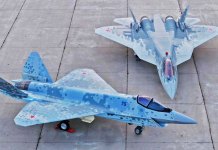India has started to receive the first regimental set of S-400 Triumf ‘SA-21 Growler’ missile defense system, Director of the Federal Service for Military-Technical Cooperation (FSMTC) Dmitry Shugaev told Sputnik ahead of the Dubai Airshow.
MQ-9 Reaper, F-35 Stealth Jet Deal In Focus At Dubai Airshow While Russia Hogs Limelight With Su-75 Checkmate
India is also in the process of establishing two squadrons of French-made Rafale fighters, which are being inducted under a deal worth €7.8 billion with Dassault. The Rafale jets just like the S-400s are dubbed as a game-changer for India against its two key adversaries – China and Pakistan.
The S-400 air defense systems, which is considered one of the most advanced of its kind, were ordered to be procured by India through a $5.43-billion deal with Russia during the 19th India-Russia Annual Bilateral Summit in 2018 at New Delhi, to ensure the long-term security needs of the country.
At €7.8B, Why Indian Rafale Jets Are ‘Double The Cost’ Than Egyptian Rafales?
On the other hand, the Rafale deal created a controversy in India, with the new government slashing the original order of 126 jets under MMRCA to just 36 in 2016, with every fighter costing a staggering $241 million under the new deal. Many alleged that the cost per plane had doubled since the original deal under the Congress government.
Comparisons have often been drawn between the Rafale jets and S-400 missile defense system – as to which of the military equipment could be a game-changer for India.
S-400 Missiles or Rafale Jets?
Nitin J Ticku as a defense expert with the EurAsian Times pin his hopes on the Russian-origin S-400 missiles being the top choice as India’s savior over the 36 Rafale jets currently being inducted.
With a range of detection that extends to as far as 600 km, the S-400 will know the moment an aircraft or a missile gets airborne in Pakistan or China. The highly mobile air defense system can be readied in a matter of minutes to execute a strike.

All the radars, missiles and launchers of the S-400 are mounted on 8×8 cross-country trucks, making them difficult to be tracked and destroyed.
The presence of 92N6E electronically-steered phased array radar on the S-400, also called the ‘Grave Stone’, can detect 300 targets over 600 kilometers away and fire four different missile types at them based on the threat and range.
One S-400 battery consists of a long-range radar, a command post vehicle, target acquisition radar and two battalions of launchers with each launcher having four tubes.
The deal with India worth about $5.4 billion dollars involves the delivery of five regiments of S-400, with each full-scale regiment consisting of 4 battalions. Each battalion is said to arm itself with 9 launchers and 120 missiles.
The S-400 missile system contains a range of missiles, and the first to be inducted was the 48N6DM (48N6E3), which is an upgraded version of the 48N6M with a powerful propulsion system with a capability to strike targets within 250 km range. It also uses the missiles of the predecessor S-300PMU system.
The missile with the longest range in S-400 is 40N6 with a capability to go up to 400km. The missile using its active radar homing can intercept air targets at great distances and target J-STARS, AWACS, EA-6B support jammers, in addition to other sophisticated targets.
With its medium-range surface-to-air missiles, 9M96E and 9M96E2, S-400 can shoot airborne targets with a high precision hit at a maximum range of 120 km.
With such firepower, the S-400 is able to destroy any incoming hostile aircraft, missiles (including nuclear missiles) stealth jets and drones within a range of up to 400 km.
The system is also designed to shoot down airborne targets with stealth technologies, and even ballistic and hypersonic missiles. That represents a tremendous capability, Ticku says.

The addition of Rafale fighter jets is a much-required boost to the Indian Air Force and you could clearly see its need during the Balakot skirmish when India missed a 4.5 gen fighter jet.
The roles of S-400 and Rafales are completely different, Nitin J Ticku emphasizes. While the S-400 has the primary role of air defense, something that the Iron Dome is doing for Israel (however with much-lesser range) the Rafales are multi-role jets typically meant for offensive roles.
With its capabilities, such as advanced avionics, radars and long-range weapon systems, the Rafale will be a formidable asset for the Indian Air Force. The S-400s, on the other hand, would complement the Rafales by neutralizing any airborne target including stealth jets, mid-air refuellers or AWACS.
However, as the then IAF chief BS Dhanoa said last year, “the Rafale jets along with S-400 missile systems will give the Indian Air Force a major combat edge in the entire region,” pointing to the fact that both the assets are indispensable for India’s defense.

He also claimed that the advanced capabilities, such as the electronic warfare suite and unparalleled maneuverability of the Rafales will enable the aircraft to “use mountainous terrain in Tibet to its advantage and blind the enemy before India’s strike aircraft penetrate hostile airspace to carry out their missions.”
Most importantly, the S-400 will compensate for the shortfalls in fighter aircraft with the IAF and lessen the defensive burden on the force.
S-400 will act as India’s air defense umbrella and the main constituent of IAF’s defense grid, giving it all-round protection against adversary threats including both China and Pakistan. The system is a significant technological leap even to its predecessor, the S-300, and has a firing rate that is 2.5 times faster.




